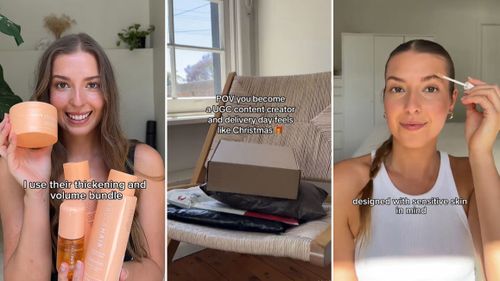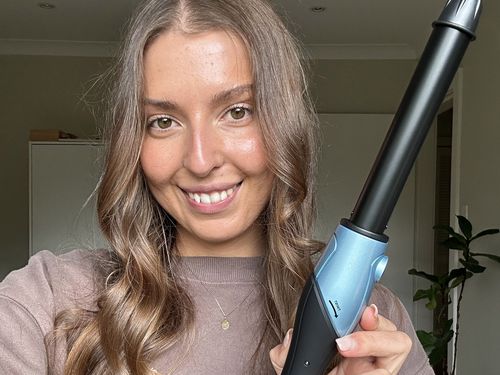Share this @internewscast.com
Three little letters helped Ashlee Sullens boost her monthly income by thousands of dollars.
The 29-year-old from New South Wales discovered user-generated content, or UGC, two years ago and has since collaborated with well-known brands such as Dove, Olay, MCoBeauty, and AfterPay.
Now she can earn up to $6000 a month through the social media side hustle without even leaving the house.

But what exactly is UGC, how does it work, and can everyday Aussies really make money doing it?
Here’s everything you need to know.
What is UGC and how does it work?
UGC is digital content created by everyday people and/or influencers to promote products or services for brands.
UGC can be used to promote everything from skincare, to restaurants, the latest tech products, and online services.
Brands typically provide free products or services to UGC creators in exchange for them making content about it.
Some brands also pay creators a fee to create content or to use it for advertising.
Common examples of UGC include:
- unboxings
- product reviews
- skincare routines
- recipe hacks

What sets UGC apart from traditional branded content is that it’s usually shot “on a phone, in real homes, by real users”.
“UGC is relatable, economical, and often outperforms traditional brand ads because it feels like a genuine recommendation rather than a sales pitch,” explained Felicity Grey, the founder and managing director of Theory Crew, a social media marketing and public relations agency.
It can also help everyday Aussies make extra cash on the side.
Sullens first noticed UGC on her social media feeds in 2023 and decided to give it a go.
Using her background in social media marketing, she started by filming videos about “random products” she had lying around the house on her iPhone.
“Before I knew it, I had brands reaching out to work together,” she told 9news.com.au.
The brand deals started small but were a great boost to her part-time income.

Want a pay rise? These jobs experienced the fastest salary growth this year
Two years on, she’s working for herself full-time and can earn anywhere between $2000 and $6000 per month making UGC.
Although there are challenges, like when a brand failed to pay her after she created content for them, Sullens said the benefits far outweigh the drawbacks.
“I love the flexibility and time freedom the most,” she said.
What role does UGC play in social media?
Most of the estimated 20 million Aussies who use social media have seen a UGC ad, though they may not have realised it.
Unlike traditional brand ads, UGC is designed to feel authentic and relatable.
That’s because it’s created by everyday people rather than a marketing team.
“As audiences increasingly desire authentic and relatable content and become more adept at recognizing overly polished advertisements, the move towards authenticity is undeniable,” Grey mentioned.
“And we know UGC ads consistently outperform branded ones.”

How did UGC become popular?
UGC may seem like a new trend but it has been slowly growing for over a decade.
Originating with bloggers and early influencers who promoted products to online audiences in the 2010s, this trend has expanded significantly with the advent of platforms like TikTok.
Brands are now embracing this trend by making UGC an essential component of their marketing strategy, employing everyday people to endorse their products and driving the UGC phenomenon.
That’s largely because traditional advertising isn’t as effective as it used to be.
UGC â which is made almost exclusively by “normal” people â checks that box.

“UGC helps bring products to life in a way traditional advertising often can’t,” Grey said.
Theory Crew built RISER, a mass influencer sampling platform, specifically to meet the demand for UGC.
And she predicts the UGC boom will only get bigger and more lucrative in the years ahead.
What is the difference between UGC creator and influencer?
Where influencers build a personal brand to attract engaged followers, UGC creators focus on making relatable content for brands.
Their photos and videos are designed to feel more natural and they don’t need a large following to work with big-name brands.
From a brand perspective, working with UGC creators typically costs less than working with influencers.
But that doesn’t mean they’re not making money; Sullens says she earns thousands of dollars every month from UGC.

“Everyday people are turning their creativity into careers, getting paid to produce content from their own homes,” Grey said.
“You don’t need a huge following, just a camera, a spark of creativity, and a willingness to show up authentically on screen.”
How do you become a UGC creator?
Getting started as a UGC creator is fairly simple, according to both Sullens and Grey.
“Shoot content in natural light, use your own voice, and focus on being helpful or entertaining,” Grey advised.
“You don’t need a massive audience, just a clear idea of what makes a good piece of content. And don’t be afraid to put yourself out there.”
You don’t need to invest in any fancy tech either.
Sullens began with an iPhone and didn’t pay for a tripod, microphone or editing software until she was already making money from UGC.

She advises beginners to research what makes good UGC, focus on video quality over quantity, and get comfortable with being on-camera.
And remember that, like most side hustles, UGC isn’t a “get rich quick” scheme that guarantees overnight success.
”As much as UGC is glamourised and seems like a super easy way to make money â which is partly true â it also takes a lot of work behind the scenes,” she said.
“There’s a lot around consumer psychology, branding, marketing and scripting that goes into each video.”












